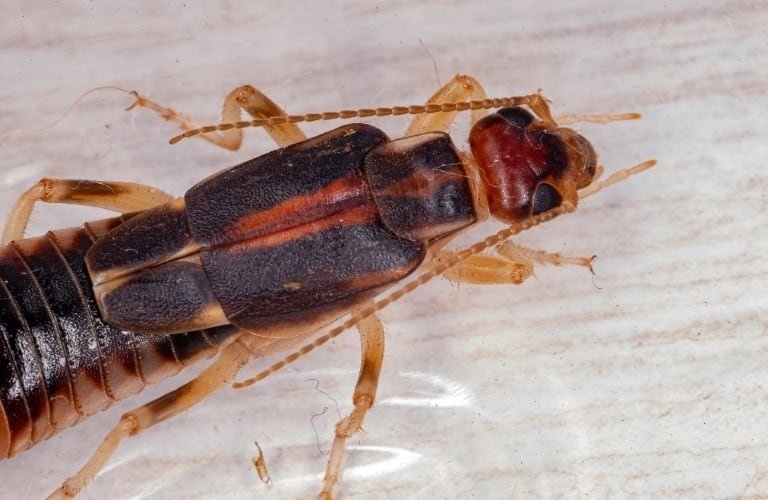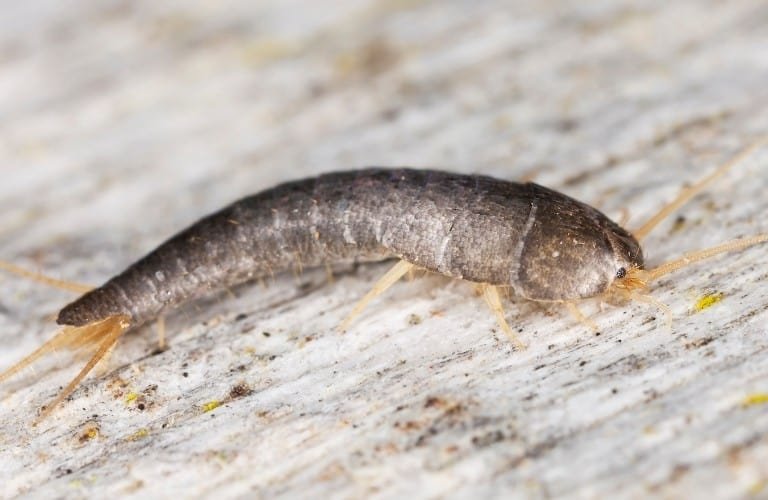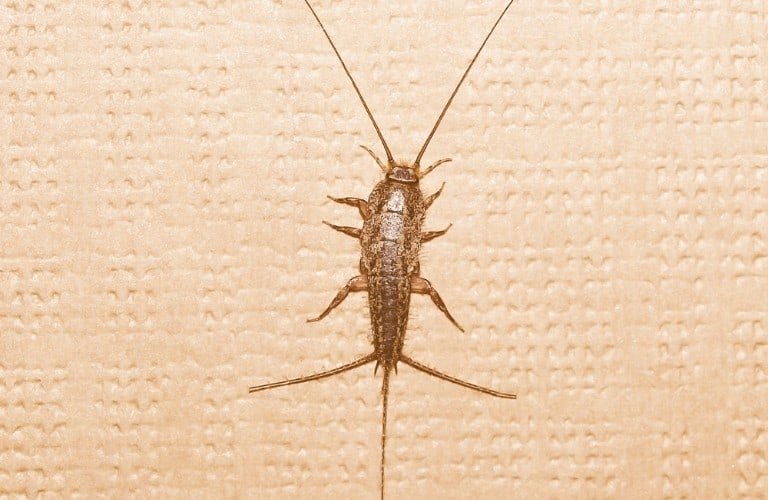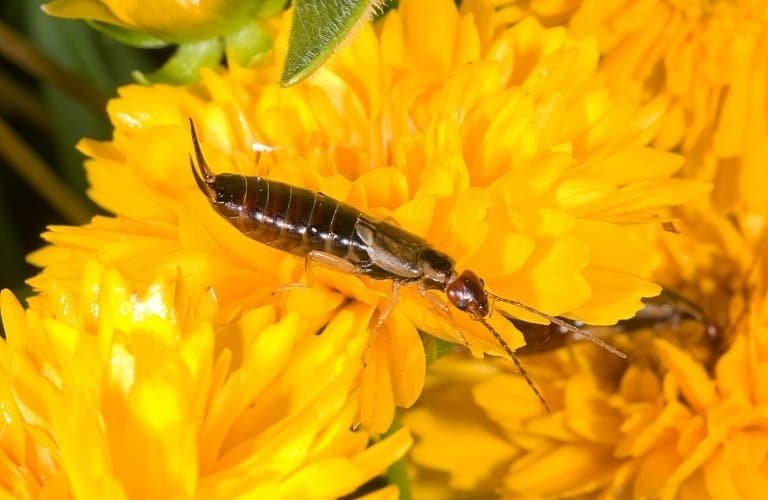Earwigs are small, fast-moving insects easily recognized by their distinctive pincers instead of a tail. While not dangerous, earwigs are unpleasant to share space with either indoors or outside.
Earwigs can be eliminated by using natural pesticides, commercial pest control products like diatomaceous earth, or by hiring a professional exterminator.
How do you get rid of earwigs? Use natural vinegar sprays and traps to eliminate earwigs, as well as natural insecticides such as diatomaceous earth. Chemical insecticides are effective too but should be used with caution. Remove decomposing yard waste and indoor attractants, and seal entry points.
By understanding the different methods and products available to get rid of these nasty pests, you can begin to eliminate earwigs immediately and avoid future infestations.
Identification
There are 22 different types of earwigs in the United States.
Despite the differences, most share the same common behaviors specific to the Dermaptera order of Forficula auricularia, or common earwig.
Shared characteristics include a flat, dark brown body about 1 inch in length with the presence of pincers, or cerci.
While earwigs seldom bite, they will pinch in certain instances. They use their pincers when threatened, while capturing prey, or during mating season.
Although many earwigs have wings, most cannot fly.
Semi-social scavengers by nature, they are primarily omnivorous, meaning they feed on both other insects and plants.
Earwigs prefer the outdoors but will move indoors during unfavorable weather conditions.
You can find them in cool, moist conditions near wet mulch, soil, crevices, or under rocks.
Common Types of Earwigs
Forficula Auricularia
Also known as the “common” or European earwig, this species is most commonly found throughout the United States.
This type of earwig is a nocturnal scavenger, searching for dark, safe places to live or nest and for food.
The primary food sources for the common earwig are decaying vegetation and other insects, either dead or alive, such as aphids, beetles, mites, and larvae of their prey.
Common earwigs are not aggressive.
An earwig pinch may sting or leave a temporary red mark on the skin for a few minutes; however, they do not inject venom or spread disease to humans or pets.
They are not particularly hardy and can be killed rather easily. We discuss what kills them here.
Labidura riparia
Another variety is known as the riparian, shore, tawny or striped earwig.
The striped earwig is lighter in color, ranging anywhere from tan to light brown, with obvious stripes found on their backs.
The striped earwig lives outdoors and thrives in dark, cool, moist conditions. They have the same omnivorous diet of plants and insects.
Anisolabis maritima
Also called the maritime earwig, this species is found primarily in the coastal regions of the United States.
They live in wet sand on beaches, feeding on insects found there.
Much like related species of earwigs, they are scavengers who hunt for food at night and hide in cool, moist spots during the day.
Maritime earwigs are darker black with a yellow belly and legs with the same unmistakable pincers. They do not have wings.
Euborellia annulipes
Generally found in the southern region of the United States, this species is commonly known as the ring-legged earwig.
The name comes from the dark rings found on their yellow legs. More black than dark brown, these earwigs do not have wings.
Ring-legged earwigs feed on both plants and insects, presenting no danger to humans or pets.
Insects Commonly Mistaken for Earwigs
Due to similar appearance and behaviors, these insects, found both indoors and outdoors, may be mistaken for an earwig.
Silverfish
Silverfish, also called fishmoth or carpet shark, are nocturnal insects who not only move quickly but resemble a swimming fish while moving.
While similar in size to an earwig, the biggest distinction between them is their color.
Most earwigs range in color from dark brown to black, while silverfish are light gray or metallic silver, hence their name.
Both earwigs and silverfish have flat bodies and grow to about 1 inch in length at maturity.
Silverfish have antennae and have three long “bristles” protruding from their back end instead of pincers.
Much like earwigs, silverfish are attracted to moisture.
They prefer dark, humid conditions and hide in wet or decomposing vegetation, such as leaves or mulch found in the yard.
Silverfish are not dangerous, but once inside a home, they are far more destructive than earwigs.
Their diet consists of sugary, starchy, carbohydrate-rich foods.
Because of their small size, they can climb into unopened bags or boxes of food. They are also known to chew and eat paper, linens, and damp clothing.
Silverfish hide in cardboard boxes typically found in basements or garages.
They are attracted to moisture and can be seen lurking near leaky pipes, dripping faucets, and sinks.
(We cover silverfish in more detail here.)
Firebrat
Firebrats are similar in appearance to silverfish with flat bodies and antennae. They also have three bristles or prongs on their back end instead of pincers.
Firebrats only grow to an adult size of ½ inch but appear longer due to the bristle tail and antennae.
They are nocturnal scavengers that move like fast swimming fish, complete with brown-colored scales on their body.
They are dark gray or brown in color but not shiny like silverfish.
Firebrats thrive in extremely hot, humid conditions found mostly indoors. They enter homes in search of humid conditions, shelter, and food.
They eat starches found in a wide variety of sources such as flour, cereal, wood, paper, and glue.
They hide near extremely hot areas in the home such as furnaces, ovens, hot water heaters and heating ducts.
Removal Methods
| Method | Estimated Cost | Natural | Odor-Free |
| DIY sprays | less than $10 | ✅ | |
| DIY traps | free | ✅ | ✅ |
| Ultrasonic devices | less than $40 | ✅ | ✅ |
| Natural insecticides | $30 | ✅ | |
| Diatomaceous earth | $15 | ✅ | ✅ |
| Insecticide sprays | less than $20 | Depends on product | |
| Insecticide dusts | $30 | ||
| Foggers | $20 | ||
| Granules | $50 | ✅ |
The Best Way to Eliminate Earwigs
Steering clear of potentially harmful pesticides is always ideal if possible.
The best way to safely eliminate earwigs is to use natural methods, such as vinegar/water sprays or homemade traps made from wet cardboard tubes.
For more severe indoor earwig problems, an ultrasonic device, such as the Zero Pest Repeller, will be highly effective in causing earwigs to leave your home.
Eliminating entry points and common attractants, such as food sources, humid conditions, and decaying yard waste, will make your home undesirable to earwigs and encourage them to leave.
Basic Guidelines
The best form of controlling earwigs from either overtaking an outside garden or entering your home is prevention.
Eliminating favorable environmental conditions like decomposing yard waste, especially near your home, greatly reduces the odds of earwig infestations.
Check with our article about earwig attractants to be sure you’re not inadvertently creating a welcoming environment for earwigs.
Indoors
Earwigs come inside through cracks found on the foundation or exterior of your home.
It’s important to thoroughly inspect your home’s exterior and repair potential areas to prevent earwigs from easily slithering inside.
Pay special attention to spaces or cracks around windows, doors, and roofs or holes for wires or cables.
Earwigs also cling to pets or your clothing as another way to get inside your home.
Follow these tips to get rid of earwigs as quickly as possible and ward off future home infestations:
- Keep kitchen counters and floors clean and free from crumbs, spills, and grease.
- Store foods such as cereal, rice, flour, and pet food in sealed, airtight containers.
- Run a dehumidifier (like this one I’ve used) in the basement.
- Fix leaky pipes or dripping faucets.
- Replace broken screens and windows.
- Repair weatherstripping around doors.
Outdoors
The best defense to prevent an outdoor earwig infestation is a clean, well-manicured lawn and yard, as earwigs hate a clean environment without sufficient hiding spots.
Consider these preventative measures:
- Rake and remove decaying yard waste, such as wet leaves, dead grass, and weeds.
- Replace wet mulch around perimeter of home with crushed rock or gravel.
- Clean gutters.
- Remove brush, wood piles, and especially rotting wood.
- Repair and seal cracks around the perimeter of the home, windows, and doors.
Natural Solutions to Get Rid of Earwigs
If you have young children and/or pets or are into organic gardening, using natural methods to eliminate earwigs may be a good choice for you.
Natural solutions to get rid of earwigs do not contain harsh chemicals, toxins, or promote accidental poisoning.
Indoor Solutions
Although severe earwig infestations indoors are not too common, some earwigs may occasionally come inside in search of food or better environmental conditions.
Earwigs will crawl out of vents, around drains in kitchen or bathroom sinks, in showers, and are frequently found in cool, dark basements.
Although earwigs pose no threat, you still will want to get rid of them quickly.
Luckily, there are lots of natural, effective solutions to choose from to banish these creatures from your home.
DIY Sprays
Here are several options that have proven to be effective. One utilizes the power of vinegar, and the other relies on rubbing alcohol.
Vinegar Spray:
- Mix equal parts of vinegar and tap water in a spray bottle.
- Spray directly on earwigs or liberally where they have been spotted, around baseboards and in dark, damp locations.
- Safe to spray in gardens and on plants in moderation.
Rubbing Alcohol Spray:
- Mix equal parts isopropyl alcohol and tap water in a spray bottle.
- Spray directly on earwigs, which will penetrate their shells and kill them almost instantly.
- Vacuum dead earwigs or scoop up and flush away.
DIY Traps
Setting traps is easy, inexpensive, and safe to use indoors.
Traps can be made from wet cardboard bathroom tissue rolls, wet rolled-up newspapers, or a piece of hose placed around baseboards or in basements.
Left overnight, earwigs will be attracted to the wet trap. In the morning, slide the trap into a bag, seal, and toss out.
Oil traps are another popular way to catch and eliminate earwigs. Leave a tuna can filled with a small amount of oil out overnight.
In the morning, toss the earwig-infested trap in a bag, seal and toss out. Add a dash of soy sauce or honey to further entice earwigs to the trap.
Ultrasonic Repeller
These electronic plug-in devices emit ultrasonic waves to repel earwigs and other insects.
The sound waves, while silent to human ears, are unpleasant enough to drive earwigs back outside to escape the noise.
There is no odor, and they’re completely safe to use around kids and pets (except pet rodents).
Bectine Pest Repeller uses an upgraded electronic chip to emit high-frequency sound waves.
These noises will humanely drive earwigs away without harming them or causing any audible sound to bother you and your family.
Natural Insecticides
Using natural pest control products kills earwigs effectively without any harsh ingredients or toxins.
Orange Guard is a broad-range, water-based insecticide derived from d-limonene, or orange peel extract, a natural repellent.
This EPA-registered product is safe to use both indoors and outdoors.
It kills and repels visible and hidden earwigs, in addition to other insects, such as silverfish, ants, and fleas. It is safe enough to use around food and is child/pet friendly.
Eco Defense is another plant-based product made with organic, nontoxic ingredients. This ready-to-spray product both kills earwigs on contact and repels them for weeks.
It is safe to use both indoors and outdoors and is also effective against other insects, like silverfish, spiders, and ants. It is a child/pet-friendly, natural insecticide alternative.
Outdoor Solutions
One concern about outdoor earwig infestations is finding a product that is safe to use around trees, plants, and gardens.
Another concern is using a product that will not cause harm, injury, or death to outdoor wildlife, like bees or birds.
Diatomaceous Earth
Diatomaceous Earth is a non-chemical, commercial product to kill insects around plants and in gardens.
The active ingredient is silica, a natural substance derived from fossilized skeletons of small organisms, or diatoms, found in streams, lakes, and rivers.
It kills earwigs and other garden-harming insects by dehydration.
A slower-acting insecticide, it breaks down the insects’ outer shell, then pulls/absorbs fat and oils from their skeletons, resulting in death.
Harris Diatomaceous Earth can be sprinkled directly in gardens and around the base of plants. Once in contact with water, it stops working and needs to be re-applied.
It contains no additives or fillers and is completely safe for use around people and pets.
Natural Insecticides
Wondercide EcoTreat works outdoors both as an infestation treatment and for preventative maintenance.
It is as strong as insecticides containing permethrin but uses all-natural ingredients such as cedarwood oil.
It can be sprayed anywhere in the yard including gardens, plants, patios, porches and exterior home finishes, like siding or brick.
For active earwig infestations, apply once per week for two weeks. For maintenance, treat areas every 30-45 days.
Wondercide is 100% child/pet friendly even before the application is dry and is safe for bees, birds, and wildlife too.
Pesticide Solutions to Get Rid of Earwigs
Pesticides describe a group of chemicals used to kill a variety of life forms, such as insects, bugs, bacteria, fungus, weeds, or diseases affecting plants.
Pesticides are broken down by name to describe what they are intended to kill or control. Examples of pesticide sub-categories are herbicides, fungicides, and insecticides.
Insecticides are products made with chemicals used specifically to kill bugs like earwigs.
Examples of effective active ingredients for insecticides include diatomaceous earth, pyrethrins, carbaryl, azadirachtin, esfenvalerate, and malathion.
There are also synthetic versions of chemical pesticides known by common names like DEET, boric acid, DDT, acephate, metaldehyde, glyphosate, propoxur, permethrin, bifenthrin, and Dursban.
Avoid using products containing highly toxic organophosphates.
They contain ingredients that are not safe to use around children and pets and may produce toxic fumes and require poison control measures if ingested.
Examples of organophosphates include:
- Chlorpyrifos.
- Diazinon.
- Dichlorvos.
- Malathion.
- Naled.
- Phosmet.
- Tetrachlorvinphos.
If you choose to use pesticides, any of the following should take care of the earwig problem quickly. For more pesticide options considered safe for home use, click here.
Insecticide Spray: Ortho Home Defense
Home Defense is designed for use both indoors and around your home’s exterior perimeter. The main ingredients are bifenthrin and zeta-cypermethrin.
Bifenthrin is a popular synthetic reproducing the natural effects of pyrethrums, derived from chrysanthemums.
Used together with zeta-cypermethrin, it works by paralyzing the insect, causing death within hours.
While deadly to earwigs, this product is safe to use in every room inside the home. It kills quickly while creating a protective barrier inside and outside of the home.
It may require several applications based on size of bugs and level of infestation.
The product is odorless, does not stain, and dries quickly after application. Product should be completely dry before introducing children and pets to treated areas.
Sevin GardenTech is another good spray that uses zeta-cypermethrin, though it is designed for outdoor use only.
This pesticide ingredient kills earwigs by affecting the nervous system, killing on contact.
If you have a vegetable garden or other edible plants requiring treatment for earwigs, this is a good option.
Insecticide Dust: Delta Dust
Finding a safe indoor insecticide with staying power means killing and repelling more earwigs with fewer applications.
This ready-made, broad-range insecticide kills earwigs with deltamethrin.
Deltamethrin is a pyrethroid, which is the synthetic counterpart to the natural insecticide pyrethrin.
Delta Dust kills insects via contact or ingestion by shutting down the nervous system.
Although this is a chemical-based insecticide, it is safe to use indoors and outdoors.
The Environmental Protection Agency classifies deltamethrin as “not likely to be a human carcinogen,” regardless of the manner of low-level exposure.
Aerosol Fogger: Black Flag Concentrated Fogger
This fogger utilizes cypermethrin to kill numerous bugs on contact.
You’ll need to do some considerable prepping before using this product however.
All food-related equipment and surfaces should be removed from the area or covered thoroughly.
You, your family, and any household pets will need to vacate the premises for two hours during application and not return until the fog has cleared and the area has been properly ventilated for an additional two hours.
Granules: Talstar PL
Talstar Pro is a professional-grade insecticide effective in killing earwigs and approximately 75 other insects and bugs.
Tha active ingredient is bifenthrin, and insects are paralyzed and die soon after contact.
It can be used to treat the yard, ornamental grasses, and plants. It is also safe for indoor use.
Talstar PL is odorless, does not stain, and most importantly, lasts for over three months per application. It does not break down easily in water or rainy conditions.
Safety Precautions When Using Pesticides
The first and foremost safety precaution when using any pesticide is to carefully read and follow all instructions.
By doing so, you will get the best possible results and remain safe throughout the process.
It doesn’t hurt to wear long pants, tennis shoes, gloves, and a mask to avoid contact and inhalation.
When applying a pesticide inside or outdoors, wait until it dries completely before walking near the treated area.
Keep children and pets away from the newly applied pesticide, as well. The warning label will tell you how long to wait until safely walking near the treated area.
- Don’t spray near dishes or food.
- Avoid eating, drinking, or smoking while applying pesticides.
- Avoid applying in windy conditions.
- Wash hands immediately after application.
- Wash skin immediately if in contact with the pesticide.
When to Call a Professional Exterminator
It’s time to call a professional exterminator if you don’t feel comfortable applying a pesticide yourself or when you still have an infestation after exhausting other methods of getting rid of earwigs.
Pest control specialists are tested, licensed, and trained to properly apply pesticides.
They may be able to offer invaluable advice as to what more you can do to help keep earwigs out of your home.
The exterminator may perform a visual inspection of your home for clues as to what is causing the infestation.
Summary
Despite your best efforts at prevention, it’s still possible to have an overpopulation of earwigs in your environment.
Once that happens, choose one of the natural or chemical pesticides discussed to successfully eradicate earwigs inside and outside your home.
Additionally, read through our other earwig prevention tips and eradicating methods to find a solution that you’re comfortable with. You can access them here.


















